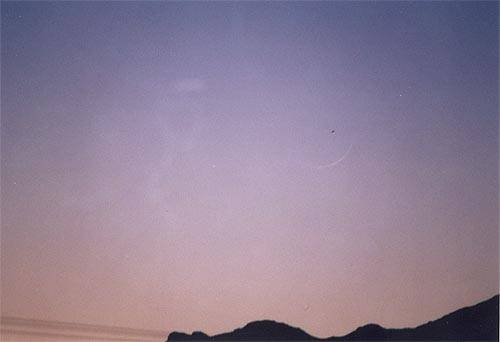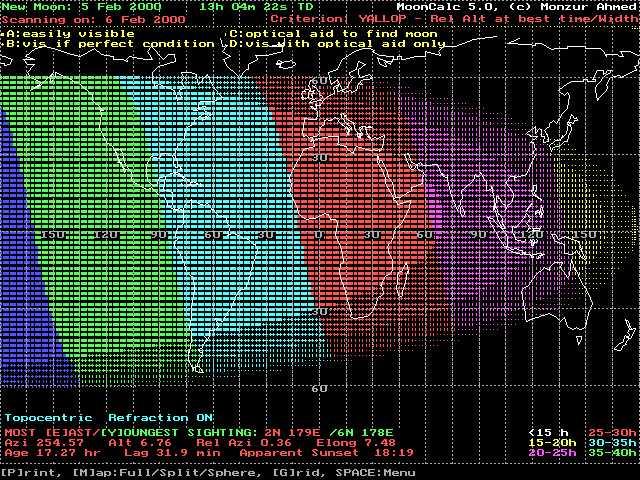
Observing the Crescent
Saturday 05 February
- Bahrain: ICOP member, Mr. Fathi Mayoof said: The Moon set before sunset by 2.5 minutes and so it was impossible to
observe the crescent."
- South Africa: ICOP member, Mr. Hashim Salie said: "The Muslim Judicial Council declared 07 February 2000, the 1st day
of Thil Qa'dah 1420." And he mentioned that no crescent was seen on 05 February.
Sunday 06 February
So far, the earliest sighting of the crescent was on 06 February from Iran, by Mr. Jamshid Arshadi & Mr. AliReza Mehrani. The crescent was also seen on 06 February from Syria, Yemen, Kenya, South Africa, and 'Trinidad and Tobago'.
- Malaysia: ICOP member, Mr. Kassim Bahali
said: "I tried to see the the crescent with binocular 7 x 50 and 8" Meade
LX200 telescope, which was tracking accurately but the western horizon was very cloudy and did not help to see the crescent. "
- Iran:
- ICOP member, Mr. Jamshid Arshadi said: "This afternoon AliReza and me observed new moon in Adib Center. We used binocular and naked eyes to observe it in addition we use camcorder to film it. We use Sony camcorder with 18 times optical magnification and we will send the copy of the film to you with the package as we promised. we also use Nikon camera with 500mm telephoto to take crescent picture. in next few days we will E-Mail these pictures to you to use them in ICOP site if you like."
- ICOP member, Mr. AliReza Mehrani said: "I saw the new moon at first with 12x70 binocular as a first person, we wanted to take picture with our 12 inches telescope but because we were sure we could see it very easily we decide to do it in next months."
- ICOP member, Mr. Asadollah Khoddam Mohammadi said: "The western horizon was cloudy. I didn't see the moon."
 Moon crescent. On
Feb. 6, 2000 at 06:15 PM. Location: Adib Center, Esfahan.
Moon crescent. On
Feb. 6, 2000 at 06:15 PM. Location: Adib Center, Esfahan.
Exposure: 1 s.
Lens: 500mm. by Alireza Mehrani.
- UAE: ICOP member, Dr. David McNaughton said: "I managed to pick up Mercury in binoculars (not with the naked eye though) - but no crescent. As of course you know, Mercury provided an extremely useful 'signpost' on this occasion - above and just right of the New Moon. I should add that that there were streaks of cirrus cloud in that part of the sky, which undoubtedly disguised the crescent (aggravated too by low-level industrial haze)."
- Bahrain: ICOP member, Mr. Fathi Mayoof said: "It was partial cloudy and a few hazy. Our plan was finding Mercury and then go to the Crescent. Around 17:40 we found Mercury by binocular and telescope and start finding the Crescent but no result we get. Around 17:50 we observed Mercury by naked eye and we continued our searching for the Crescent. We stayed there until 18:10 (the crescent set at 18:15) but no result."
- Saudi: ICOP member, Mr. Saleh Al-Saab said: "Although the altitude of the Crescent was more than ten degrees, the telescope was tracking accurately but the weather did not help to see it."
- Jordan: Every possible choice was tried! The sky was cloudy over Amman, we kept calling the meteorological departments in Al-Shoubak (220 Km South of Amman), and Al-Azraq (110 Km East of Amman), and both insisted on the bad weather conditions! However, three JAS members insisted to go to Al-Azraq!! Namely: Yahya Bani Hamad, Ahmad Niamat, and Moh'd Odeh. Knowing that as we traveled to Al-Azraq the meteorological department there informed us that the sky is cloudy and the weather is heavily dusty! Nevertheless, we went there! It is a desert where the conditions may totally change within less than an hour! Don't you believe ? Then just continue reading!! As we reached Al-Azraq, we found it cloudy and very windy, but not dusty! Good we said! However, the sky kept covered... Even though there was a small gap in the western horizon, it was not at the crescent's location! It was extremely cold! Unfortunately, we gave up after the gap (the only hope) vanished!!! The sky is totally -heavily- cloudy now. We went down, and then we visited the meteorological department, which is luckily located just a few meters away of our observation location. They were so kind! AND........ While we were talking, a worker there told us: I have a good news!!!! It is totally clear now!!!!!! I looked at him, and told him: Actually this is NOT a good news :-) !!!!
- Syria: ICOP members, Dr. Hasan Bilani mentioned that the crescent was seen by naked eyes.
- Yemen: ICOP member, Mr. Mojahid Najem said: " This is my first try to talk about crescent visibility. It was seen by others and by myself very clearly. One more thing, the west is blocked in Sana'a by mountains, and the Moon and the Sun set behind them."
- Kenya: ICOP member, Mr. Mahmood Essa said: " I have pleasure in letting you know that Alhamdullilah we sighted the
crescent this evening 19.05 local time. The sky was quite clear . The crescent was very thin and not far above the horizon. We spotted it with naked eyes. There were four of us who saw it . It was visible for about 15 minutes before it disappeared below some tree cover."
- South Africa: ICOP member, Dr. John Caldwell said: " Quite good conditions except 2 deg cloud band on western horizon. Caldwell, Dave Laney, and Mr. and Mrs. Ebrahim Jakoet all observed
together and all agreed on seeing the crescent visually which got
easy from 20:15 onwards. Mercury was 2 degrees away which helped. Fuller report at the South African website in a day or two."
- Canada: ICOP member, Mr. Mohammad Farooq said: "In Hamilton Ontario the age of the moon at sunset time was 33hrs
35mins, therefore elongation, altitude and moonset time, all of these conditions were sufficient to sight the the crescent, but unfortunately due to cloudy horizon I was unable to sight the crescent."
- Trinidad and Tobago: ICOP member, Dr. Shirin Haque-Copilah said: "The crescent on Sun 6th Feb. was very easily visible naked eye, therefore binoculars or telescope was not needed. It was easily visible before the required 'best time' for the sun to get 5 degrees below horizon. The horizon was obstructed by buildings so not clear to say when it was 'last seen'."
Monday 0y February
- Nigeria: ICOP member, Mr. Alabi Isiaq said: "This is to inform you that the crescent for the month of Thul-keadah was
sighted here (Lagos, Nigeria) on Monday (07/02/2000) evening. Whether or not Saudi Arabia adjusts their erroneous and misleading calendar is immaterial, so long as ICOP is able to establish the facts of crescent sighting. They are free to do what they like. But we must endeavor to sensitize as many people as possible, that they might be free from the bonds of SA."

The First Day in Different Countries
Sunday 06 February:-
- Jordan
- Palestine
- Kuwait
- UAE
- Bahrain
- Qatar
- Egypt
- Tunis
- Algeria
Monday 07 February:-
- Saudi (After 31 days of Shawwal!!!)
- Oman
- Iran
- South Africa
Tuesday 08 February:-
- Nigeria
- Pakistan

The Accuracy of The Astronomical Calculations
To know about the accuracy of the astronomical calculations, then please click here













